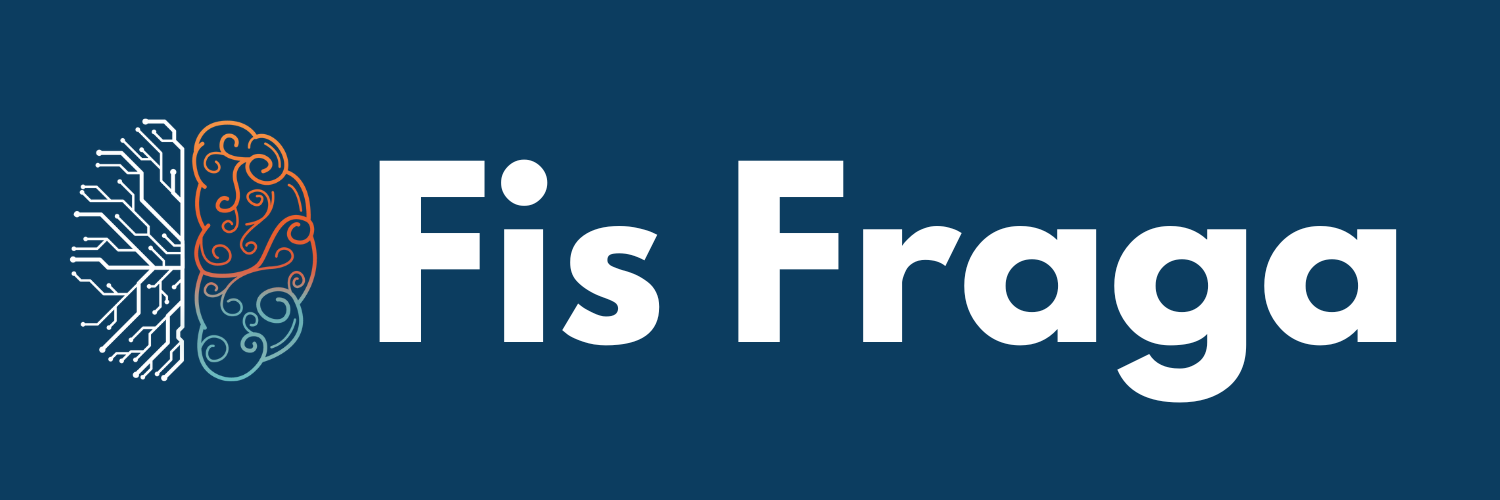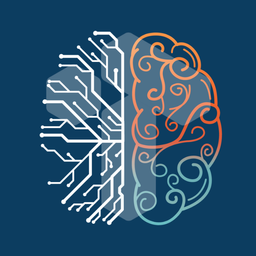no.23 - Tana is a Knowledge Base Integrated with AI to Give You Superpowers.
Understand how Tana is revolutionizing Artificial Intelligence using Knowledge Management.

Tana is a state-of-the-art tool for Knowledge Management.
Tana also brings a whole new way to use AI.
It's like NOTHING you’ve seen before.
Trust me when I say this, I've got a M.Sc. in Computer Science, and have deeply studied Tana for over 18 months.
So…
What is Tana?
Tana is an interconnected knowledge base for your notes.
But let's dig deeper into this…
Here is the description found in Tana's website:
A new digital environment that unlocks the potential of human-AI collaboration.
Wow!! This sounds powerful.
Let's understand what this actually means:
How does Tana unlock the potential of human-AI collaboration?
Tana has 3 major components:
- Tana is an Interconnected Knowledge Base
- Tana connects directly with Generative AI
- Tana’s Supertags are Software Programs
When you bring everything together, Tana becomes super important to navigate the current AI era we live in.
Intelligence does not exist in a vacuum.
(Artificial) Intelligence depends directly on the data you use.
Just as a house depends directly on the building material you use, and a cooked dish depends directly on the ingredients you use… AI’s capacity to extract, or generate, relevant information depends directly on how your data is curated, organized, and presented.
If you don’t provide additional data, the “intelligence” that you’re summoning is a broad and low-quality intelligence.
When you use a normal LLM (Large Language Model), such as ChatGPT, you get results based on the original data used to train it, around 300 billion words about ANY RANDOM subject.
Now let me ask you a question:
The answer is NO.
To get truly high-quality answers you need high-quality data.
It’s quite simple.
But not easy. (Well, at least not without Tana…)
Tana presents a powerful bridge between:
- Generative AI functionalities
- Curated and organized knowledge (even better than data)
Your knowledge in Tana is labeled, well organized, connected, and easily segmented.
The Knowledge Base structure makes it much easier to SEND high-quality data to LLMs.
And as a result… it’s possible to RECEIVE high-quality results from AI.
Best of all:
You can then STORE the high-quality results as input to your existing knowledge, also labeled, well organized, connected, and easily segmented.
Let’s dive deeper into how this works.
💬 Quote Time ⏳
“Tana is one of the few knowledge management tools that moves beyond mimicking static text on paper. It takes the computational medium seriously. It gives regular folks access to a powerful set of primitives that previously only developers could touch.”
– Maggie Appleton
(h/t Andrew Altshuler for this quote)
Tana turns you into a developer. Without needing to know how to code.
This is serious stuff.
You’ve seen the predictions that “in the future everyone will be a developer”.
The future is here, my friend.
And it may be even more powerful than you think… Tana DOES NOT JUST turn you into a developer.
Tana gives you a powerful Knowledge Base (i.e. better than a Database) to store your knowledge in a structured and connected way.
So that your knowledge fuels the Software you develop.
1. A Supertag is a Software
Let’s demystify ‘Software’ into something easy to understand.
A Supertag in Tana work like a software program, where:
- Fields store information
- Commands execute actions
Below, you’ll find the Supertag Template for a supertag called #highlight and a Class Definition for the same supertag.
A Class is a concept from Object-Oriented Programming.
Classes represent blueprints to create objects (this is why it’s object-oriented). Classes provide: 1. places to store information (fields) and 2. implementations of behaviors (commands).
Just like the Supertags.
This diagram shows a breakdown of the #highlight supertag, showing all the Fields that store information, and all Commands that execute actions.
It’s important to note that Tana has AI Fields, which work simultaneously as both a Field AND an AI Command.
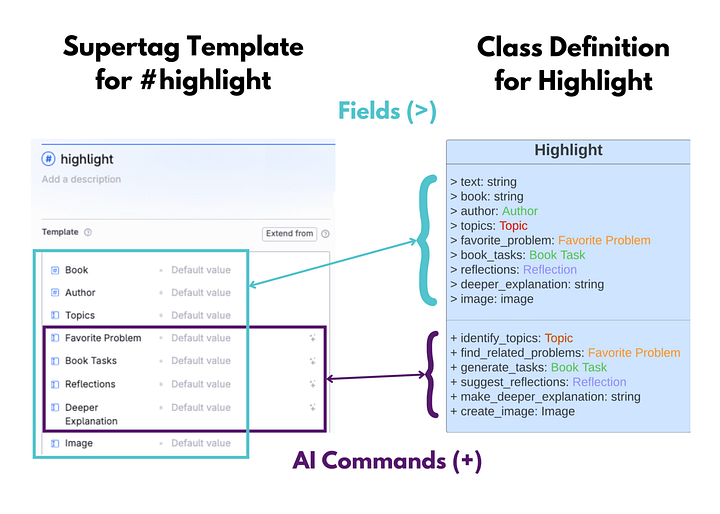
2. Example of a Software Supertag
Enough of theory! Let’s see an example.
Below, you will find an object created with the #highlight supertag, where all the commands described above were executed, and the results were stored in the fields.
OBS. This object was empty. Only the Book and Author fields had data.
All the rest was generated (assigned) with AI:
- Image
- Topics
- Favorite Problems
- Book Tasks
- Reflections
- Deeper Explanation
This is what I mean by a Software. ↓
Keep in mind that this can be configured to run automatically, without needing to click anything (using the “On added” configuration).
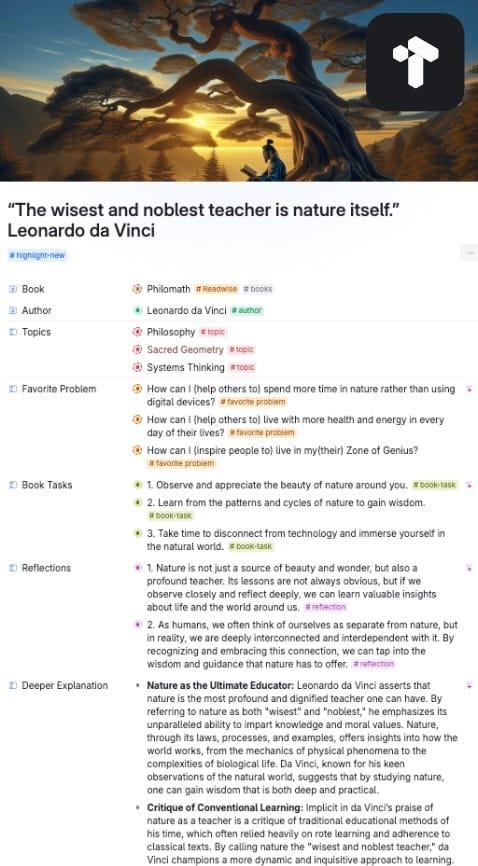
The 3 Main Components in Tana
As we’ve seen earlier, Tana has 3 major components.
- Tana is an Interconnected Knowledge Base
- Tana connects directly with Generative AI
- Tana’s Supertags are Software Programs
It’s important to understand how everything fits together.
Let’s break down each of these components (in reverse order), and then conclude by connecting it all.
3. Tana’s Supertags are Software Programs
As we’ve seen, Supertags act like Software Programs.
But there is a simpler, central function. The basic function of a Supertag is:
… a normal tag.
A tag is used to clearly label a piece of knowledge, to indicate that something belongs to a specific type or category.
This is very relevant to find data in Tana, and also to segment data. You can easily find any node that belongs to a certain category, and also separate them according to their type.
With this, and what we’ve seen before, Supertags can:
- Store Information
- Run Commands
- Clearly label pieces of Knowledge
- Interact with other Supertags
2. Tana connects directly with Generative AI
A big part of AI Commands in Tana goes through Generative AI.
Generative AI is an AI that generates content. This is usually done by an LLM, such as ChatGPT.
‘Generation’ is actually a broad term.
You can generate several different outputs using an LLM:
- Extract components from existing data (Generate components)
- Create images from text (Generate images)
- Elaborate on some idea (Generate explanations)
- Summarize existing data (Generate summary)
- Assign tags to data (Generate tags)
- Create new data (Generate data)
↑ All of these are forms of ‘generation’
This means you have one command in Tana, ⚙️ Ask AI, that can execute several different jobs (if you know how to use it).
OBS. You can use Generative AI inside a Supertag or outside a Supertag.
1. Tana is an Interconnected Knowledge Base
The final piece of the puzzle is Tana’s data structure.
Tana is a Knowledge Graph, or a Knowledge Base.
By definition, a graph — G(V,E) — has Vertices (Nodes) and Edges. But what you need to understand is that in Tana everything is interconnected.
Connections are super important, they create bridges between different Supertags, and consequently between different nodes (objects).
Remember the image above, you’ll see that the #highlight supertag is actually connected to several other tags, such as #books, #author, #topic, #favorite problem, #book task, and #reflection.
Here is an example of what this would look like.
In this image, there are only concepts and an author, but it serves to show that a network is formed when you add different notes.

This is central to how Tana works, because the different supertags (software) are connected.
This means you can always access complementary information, and have a true network of knowledge (even though you still can't see the graph view in Tana yet).
Bringing it all together
Tana is a very advanced tool, that leverages your knowledge in a powerful way, by clearly labeling and organizing knowledge.
You can easily send organized data over to Generative AI models (ChatGPT), resulting in higher-quality output, and faster design of AI functionalities.
This is all supercharged by the supertags, which are software programs that can be connected with each other in fluid workflows.
Further Reading
Collider Article: Blueprint for Accelerated Expertise
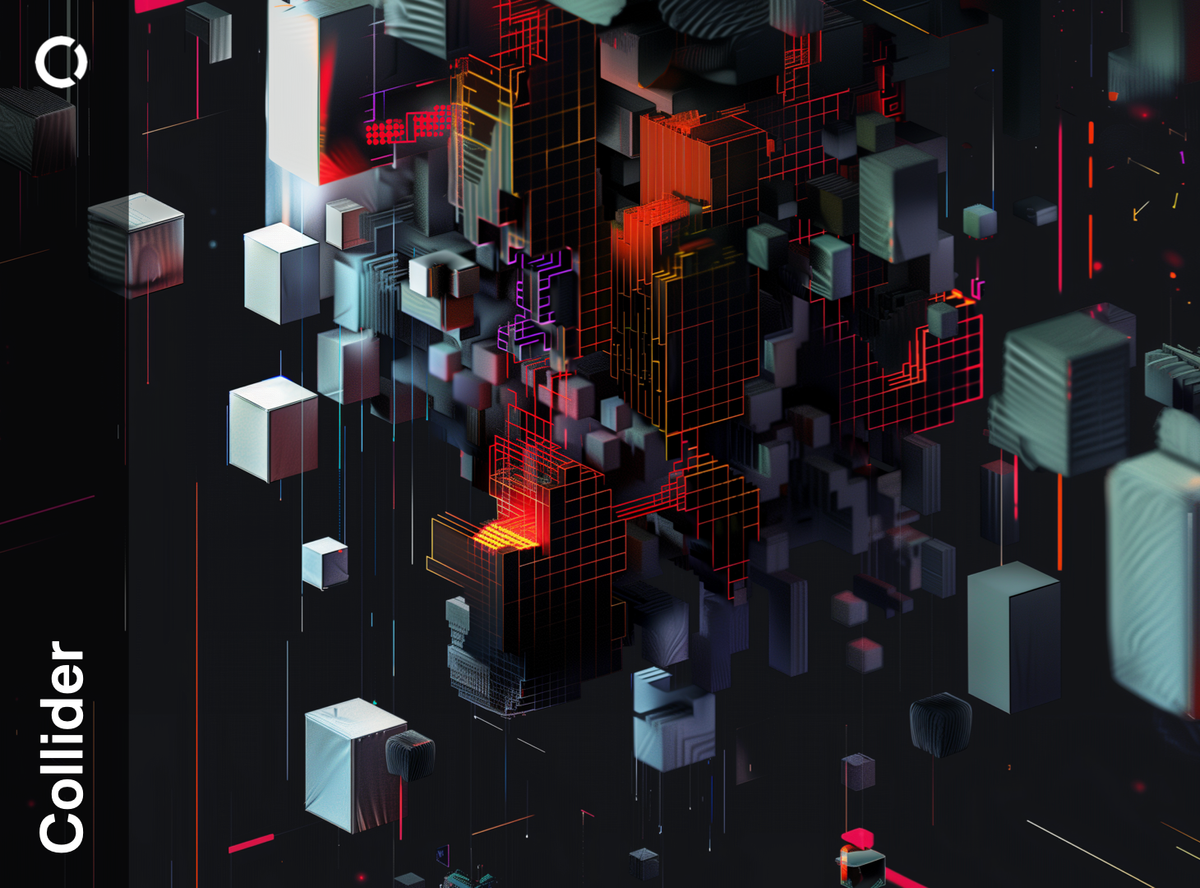
My co-founder, Andrew, has written a fascinating article for Collider talking about Accelerated Expertise.
This article covers several ways that Tana helps us navigate this era of accelerated complexity. It covers several mindsets and concepts that Tana builds upon to provide intelligent solutions for modern times.
Don’t forget to subscribe to Collider, as we are preparing a series of great content and experiences to be released soon.
Hope you enjoy!
Thank you for reading!
Fis Fraga, M.Sc. is a Tana Ambassador and digital writer. He helps people develop a productive and fulfilling life using a mix of Knowledge Management, and Artificial Intelligence.
You can read more at:

